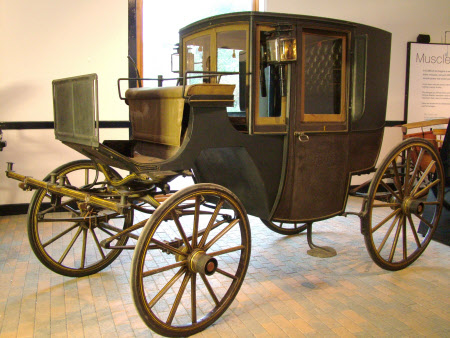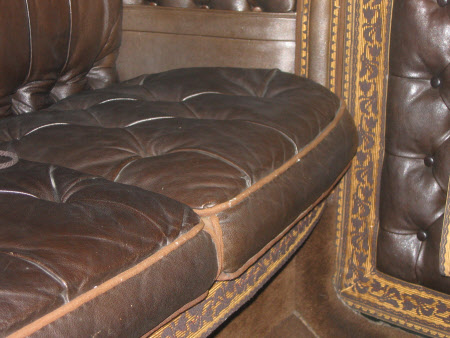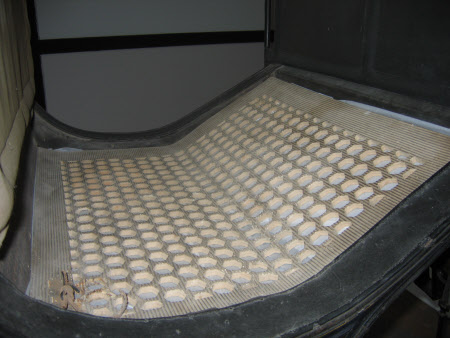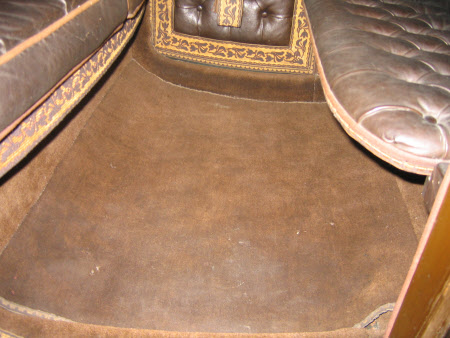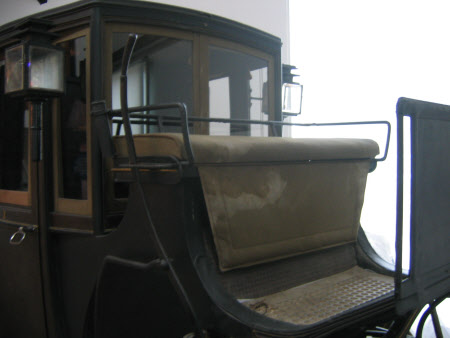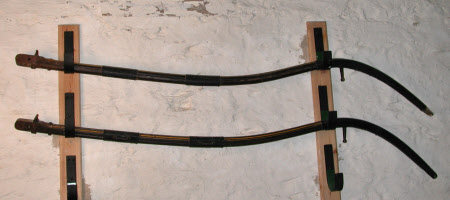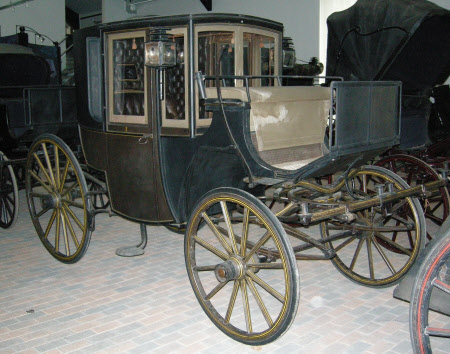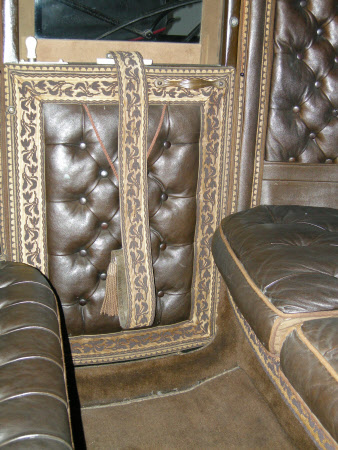Double brougham
W Cole & Sons
Category
Carriages & other vehicles
Date
1893
Materials
Bone, Glass, Leather, Rubber, Textile, Wood
Measurements
2010 x 1600 mm; 3250 mm (Length)10 cwt (Wt)
Place of origin
Kensington
Order this imageCollection
National Trust Carriage Museum
NT 272905
Summary
Double Brougham built by W. Cole & Sons, Kensington for Lieutenant-Colonel Francis Marwood Hext, London, circa 1890.
Full description
Conventional but very good double Brougham with angular profile. Coachman’s seat with single seat rail. Fixed heel board in boot, dropped footboard between moulded brackets. Leather-covered roof and upper panels. In chocolate and gold livery, with chocolate leather upholstery and gold silk blinds and 4 cushions. On full elliptic springs and with pole and shafts and removable splinter bar. This brougham was built as a wedding present for Lieutenant-Colonel F.M.Hext of Redhayes, Pinhoe, near Exeter, in 1893 by W. Cole & Sons, Kensington, London, and used by him on his honeymoon on the Isle of Wight. It is painted in the family colours of chocolate and gold, and the superb interior trimming is in the same colours. The front seat in the body can be folded away when not in use but, with it in place, it can seat four. It would be coachman-driven, with a groom beside him, and pulled by a single horse or a pair. Lieutenant Colonel Francis Marwood Hext was the fourth surviving son of Thomas Hext of Tranarren, St Austell. He was born in 1860, was created Lieutenant-Colonel in 1888 and married Florence Petherwick on the 17th June 1893. He became High Sheriff of Devon in 1933 and died on the 21st December 1944. The first brougham was commissioned in 1837 by Henry Peter Brougham (1778-1868) first Baron Brougham and Vaux, Whig politician, lawyer and Minister of State. He wanted “a refined and glorified street cab, which would make a convenient carriage for a gentleman”, unlike his usual form of transport, probably a town coach or chariot, both far larger and heavier. He designed a carriage that would be light and compact, needing just one horse and a coachman – ideal for use on busy streets. The body would be low for easy access and should carry two people and be “closed and intimate thus allowing the occupants to conduct a private conversation whilst travelling”. His ideas were rejected by his usual coachbuilder so he took them to another, Robinson & Cook, just round the corner. They agreed to build the vehicle and it was called the Brougham by his Lordship’s express permission. Lord Brougham’s brainchild was an instant success and, within a few years, broughams were being built in vast numbers wherever carriages of Western European style were used. They were particularly popular with professional and middle class families, and became the everyday carriages of the wealthy and the aristocracy. CJN 17.11.06 BODY Conventional but very good double Brougham with angular profile by little known builder, which proves that it was not only the great names in 19th century coach building who produced work of the highest quality. Coachman’s seat with single seat rail. Fixed heel board in boot, dropped footboard between moulded brackets. Leather-covered roof and upper panels. Staples for roof basket but basket missing. Hole for communication cord in front rail. The front seat can be hinged up when it is not in use, and it is retained by a strap. Doors Doors on two concealed hinges and one outrigger hinge, with silver plated, rectangular sham fall-down handles. Steps Semi-circular jagged plate steps at doors with door-mounted step covers. Jags worked on outer stock hoops of front wheels, and rectangular jagged plate steps at brackets. Windows Lowering windows in doors, sliding front windows, and fixed front quarter windows. Frames covered with drab cloth. No panel blinds or provision to fit them. Rectangular back light with radiused corners. Lamps Square lamps with three-tier square chimneys and painted trim. These lamps do not belong to this carriage, and were bought in 2003. They are correct and appropriate for this carriage. Repair needed to nearside lamp so that it is mounted vertically. External Furniture Brass. CARRIAGE Wheels Twelve and fourteen spoke English pattern wheels with staggered spokes and grey wired on tyres except on the offside front wheel which has a black rubber tyre in a clincher channel. Axles Collinge’s patent axles – straight. Springs Elliptic springs front and back. Fore carriage Open futchell fore carriage with straight transom and very slightly compassed horn bar, slightly inclined forward and backward respectively, deeply compassed axle bed, full wheel plate and sway bar. The transom is not of the conventional shape supporting the wheel plate each side. It is more V-shaped than usual and the sides of the wheel plate are connected to it by iron stays. The horn bar, which is a similar shape, is supported by the sway bar. The axle bed does not sit on top of the springs in the usual way, but is butted up to them for most of its depth. Only the top section is continuous through the wheel iron head. Beautifully carved oval fiddle heads. Straight splinter bar. The painting shows that the nearside splinter bar clip has been moved approximately 14mm towards the end of the bar for no apparent reason. Hind carriage Iron pump handles. Slender waisted hind axle bed with carved fiddle heads to match the fore carriage. Brake Lever action brake with linkage that nicely matches the profile of the wheel arch, finishing with a curved iron handle.Rack bolted to seat board, with lugs that pass through the seat valance.Price’s patent iron spring assisted, self-aligning brake blocks. Paint Roof, boot, body frame, underside of floor – black. Lower panels, wheels, carriage – brown. Fine yellow line on step of body frame mouldings. Broad black line centred with medium yellow line and edged with two fine yellow lines on wheels, springs, fore carriage and hind axle bed. Heraldry Crest on fence rails. Leather Dashboard, splash guards and seat valance are enamelled leather (most enamelling was lost during conservation work in 1990?)The brackets and tow board are lined with leather. Seat rails are leather-covered. Roller bolt leathers except nearside inner cap leather which is missing. External Trimming Long driving box is covered with drab cloth with fawn seaming laces. The seat fall is the same cloth lined with black leather cloth. The heel board is covered with floor cloth with a stencilled pattern of black and coral pink crosses on a brown ground. A white ribbed rubber mat with perforated hexagonal pattern on footboard and front floor. Internal Trimming Back, front and quarter squabs, seat cushions and seat backs, back light squab – deep buttoned dark brown Morocco with buttons covered with the same. Roof lining – brown cloth. The floor is covered with floor cloth with a stencilled pattern of black and coral pink crosses on a brown ground. The structure below the seat boards is lined with brown cut pile carpet, and there is a loose square of similar carpet on the floor. The broad laces have a brown foliage repeat figure with a single orange thread through the centre on a gold silk ground. Matching pasting laces. There are no hand holders. Brown silk taffeta spring curtains with brown wool and silk tassels and acorns. Approximately 780mm of coachman’s communication cord is on the back seat, with heavy gold and brown tassel. The remainder of the cord is missing. There are eyes on the roof to guide the cord from the front rail to the back seat.
Provenance
see letter from Mrs. Hext dated 31st March (?) in file.
Makers and roles
W Cole & Sons, coach builder


